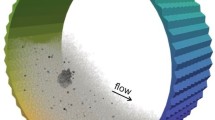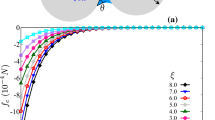Abstract
A model is developed to describe dendritic agglomeration in microscale granular flows. The individual particulate grains under consideration are approximated as being spheres that remain spherical after impact. The spheres may adhere to one another, forming branched aggregates (“dendrites”), based upon an empirical contact pressure relation. The possibility for fragmentation is also included in the analysis. The computational model developed is used to demonstrate agglomeration behavior in granular flows for a range of control parameters. The results indicate that there is a transition from size-unstable agglomeration to size-stable agglomeration; which is controlled by the velocity field and the material properties.
Similar content being viewed by others
References
W. Benz. Impact simulations with fracture. 1. method and tests. Icarus, 107:98–116, 1994.
J. Blum and G. Wurm. Impact simulations on sticking, restructuring, and fragmentation of preplanetary dust aggregates. Icarus, 143:138–146, 2000.
A. Chokshi, A. G. G. M. Tielens, and D. Hollenbach. Dust coagulation. The Astrophysical Journal, 407: 806–819, 1993.
C. Dominik and A. G. G. M. Tielens. The physics of dust coagulation and the structure of dust aggregates in space. The Astrophysical Journal, 480:647–673, 1997.
R. H. Huijser, E. G. Van der Sar, and R. Schelling. Cosmic dust aggregation in microgravity flight report of the codag module on maser 8. In Proc. 14th ESA Symposium on European Rocket and Balloon Programmes and Related Research, pages 511–516, Potsdam, Germany, September 1999.
V. F. Nesterenko, M. A. Meyers, H. C. Chen, and J. C. LaSalvia. Controlled high rate localized shear in porous reactive media. Applied Physics Letters, 65(24):3069–3071, 1994.
D. C. Richardson, T. Quinn, J. Stadel, and G. Lake. Direct large-scale n-body simulations of planetesimal dynamics. Icarus, 143:45–59, 2000.
S. Sirono and J. M. Greenberg. Do cometesimal collisions lead to bound rubble piles or to aggregates held together by gravity? Icarus, 145:230–238, 2000.
I. Termizer. A computational model for aggregation in a class of granular materials. Master’s thesis, University of California at Berkeley; Berkeley, California; May 2004.
S. J. Weidenschilling, D. Spaute, D. R. Davis, F. Marzari; and K. Ohtsuki. Accretional evolution of a planetesimal swarm. Icarus, 128:429–455, 1997.
G. Wurm, J. Blum; and J. E. Colwell. A new mechanism relevant to the formation of planetesimals in the solar nebula. Icarus, 151:318–321, 2001.
T. I. Zohdi. Large-scale statistical inverse computation of inelastic accretion in transient granular flows. International Journal of Nonlinear Mechanics, 38(8):1205–1219; 2003.
T. I. Zohdi. Modeling and direct simulation of near-field granular flows. The International Journal of Solids and Structures, 42/2:539–564, 2004(a).
T. I. Zohdi. (accepted) charge-induced clustering in multified particulate flows. International Journal of Numerical Methods in Engineering, 2004(b).
Author information
Authors and Affiliations
Rights and permissions
About this article
Cite this article
Temizer, I., Zohdi, T.I. Agglomeration and refragmentation in microscale granular flows. Int J Fract 131, L37–L44 (2005). https://doi.org/10.1007/s10704-005-2598-7
Issue Date:
DOI: https://doi.org/10.1007/s10704-005-2598-7




